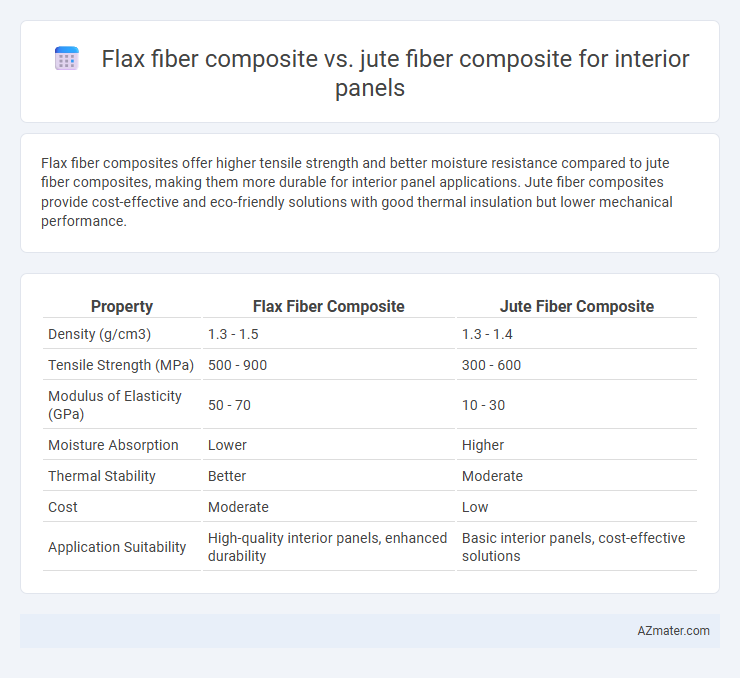Flax fiber composites offer higher tensile strength and better moisture resistance compared to jute fiber composites, making them more durable for interior panel applications. Jute fiber composites provide cost-effective and eco-friendly solutions with good thermal insulation but lower mechanical performance.
Table of Comparison
| Property | Flax Fiber Composite | Jute Fiber Composite |
|---|---|---|
| Density (g/cm3) | 1.3 - 1.5 | 1.3 - 1.4 |
| Tensile Strength (MPa) | 500 - 900 | 300 - 600 |
| Modulus of Elasticity (GPa) | 50 - 70 | 10 - 30 |
| Moisture Absorption | Lower | Higher |
| Thermal Stability | Better | Moderate |
| Cost | Moderate | Low |
| Application Suitability | High-quality interior panels, enhanced durability | Basic interior panels, cost-effective solutions |
Introduction to Natural Fiber Composites
Natural fiber composites, such as flax fiber composite and jute fiber composite, offer sustainable alternatives for interior panels due to their lightweight properties and eco-friendly composition. Flax fiber composites provide superior mechanical strength and dimensional stability, making them ideal for high-performance interior applications. Jute fiber composites excel in cost-effectiveness and biodegradability while maintaining adequate durability for decorative and non-structural interior panels.
Overview of Flax Fiber Composites
Flax fiber composites are natural fiber-reinforced materials known for their high strength-to-weight ratio, excellent vibration damping, and biodegradability, making them ideal for sustainable interior panels. These composites exhibit superior mechanical properties compared to jute fiber composites, including higher tensile strength and stiffness, contributing to enhanced durability and impact resistance in automotive and building interiors. Their lightweight nature and eco-friendly profile support reduced environmental impact while maintaining aesthetic appeal and structural performance.
Overview of Jute Fiber Composites
Jute fiber composites offer a cost-effective and sustainable solution for interior panels with excellent biodegradability and moderate mechanical strength. These composites demonstrate good thermal insulation and sound absorption properties, making them suitable for automotive and building applications. The natural lignin content in jute enhances moisture resistance, though it generally exhibits lower tensile strength compared to flax fiber composites.
Mechanical Properties: Flax vs Jute Composites
Flax fiber composites exhibit superior tensile strength and stiffness compared to jute fiber composites, making them more suitable for interior panel applications requiring enhanced mechanical performance. The higher Young's modulus and impact resistance of flax composites contribute to better durability and structural integrity in automotive and furniture interiors. Jute composites, while more cost-effective and environmentally friendly, generally have lower mechanical properties and are preferred for applications where flexibility and lightweight characteristics are prioritized over high strength.
Thermal Performance Comparison
Flax fiber composites exhibit superior thermal insulation properties compared to jute fiber composites, with lower thermal conductivity values typically ranging from 0.035 to 0.045 W/m*K, enhancing energy efficiency in interior panels. Jute fiber composites, while cost-effective, generally have higher thermal conductivity around 0.05 to 0.06 W/m*K, resulting in less effective heat retention and reduced thermal comfort. The crystalline structure and fiber morphology of flax contribute to its better thermal resistance, making it a preferred choice for sustainable interior panel applications requiring improved thermal performance.
Aesthetic and Surface Finish Qualities
Flax fiber composites exhibit a finer, more uniform surface texture than jute fiber composites, providing enhanced aesthetic appeal and smoothness for interior panels. The natural sheen and consistent fiber alignment in flax contribute to a premium finish that is less prone to surface irregularities compared to the coarser, uneven texture of jute fibers. Flax composites also offer better dye absorption and color retention, resulting in more vibrant and durable interior panel finishes.
Environmental Impact and Sustainability
Flax fiber composites exhibit superior environmental benefits due to their lower carbon footprint and faster biodegradability compared to jute fiber composites, making them ideal for sustainable interior panels. Flax cultivation requires less water and pesticides, enhancing its eco-friendly profile, while jute fiber composites, although renewable, involve more intensive water usage and longer processing times. Both materials support circular economy principles, but flax fiber composites lead in reducing environmental impact and promoting sustainability in interior panel applications.
Cost and Economic Considerations
Flax fiber composites generally offer a higher initial material cost compared to jute fiber composites, but their superior mechanical properties can lead to longer-lasting interior panels and reduced maintenance expenses. Jute fiber composites remain more economically viable for large-scale, cost-sensitive projects due to their lower raw material and processing costs. Evaluating lifecycle cost analysis reveals flax composites may provide better value in premium applications, whereas jute composites suit budget-conscious designs.
Applications in Interior Panels
Flax fiber composites offer superior mechanical strength and moisture resistance, making them ideal for automotive and furniture interior panels requiring durability and lightweight properties. Jute fiber composites provide excellent thermal insulation and eco-friendliness, commonly used in decorative and acoustic interior panel applications within residential and commercial buildings. Both materials are biodegradable alternatives to synthetic composites, with flax favored in high-performance contexts and jute preferred for cost-effective, sustainable interior solutions.
Conclusion: Best Choice for Interior Panel Uses
Flax fiber composites offer superior mechanical strength, lower density, and better moisture resistance compared to jute fiber composites, making them highly suitable for interior panel applications requiring durability and lightweight properties. Jute composites, while cost-effective and sustainable, tend to have lower impact resistance and dimensional stability, limiting their use in high-performance interior panels. For interior panel uses prioritizing strength, longevity, and moisture management, flax fiber composites present the best overall choice.

Infographic: Flax fiber composite vs Jute fiber composite for Interior panel
 azmater.com
azmater.com